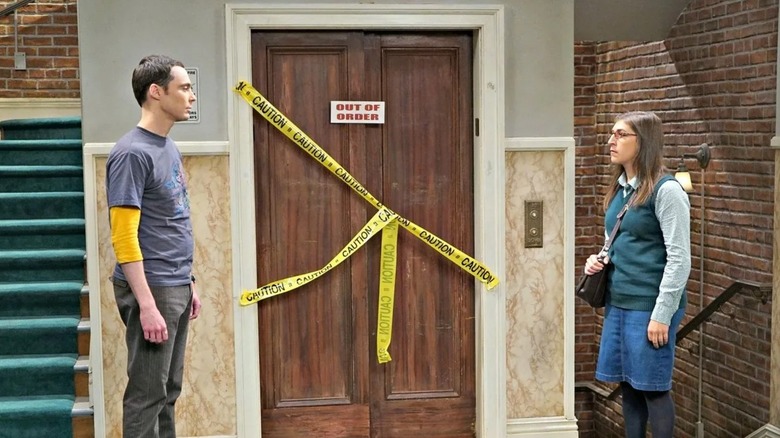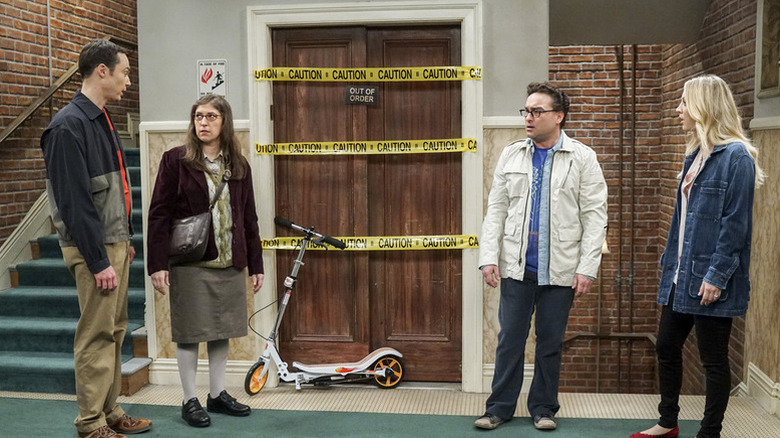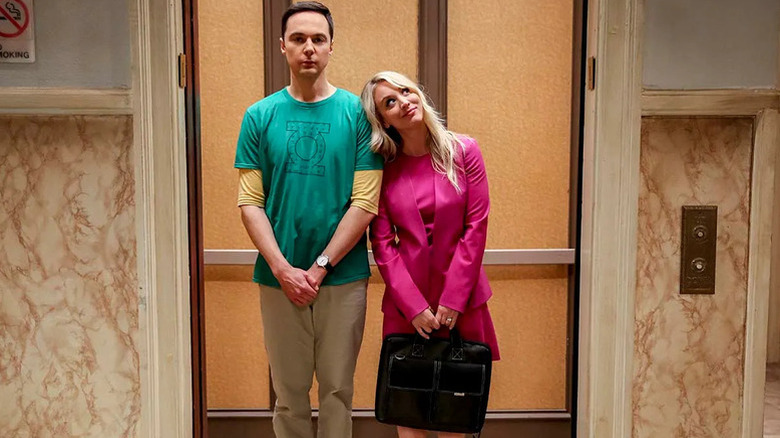The Big Bang Theory Gag That Makes No Sense
We may receive a commission on purchases made from links.
If there's one thing fans know about "The Big Bang Theory," it's that within the show's universe, the elevator in the gang's apartment building is broken. Let me clarify: even though only Sheldon Cooper (Jim Parsons), Penny (Kaley Cuoco), and Leonard Hofstadter (Johnny Galecki) — and eventually Amy Farrah Fowler (Mayim Bialik) — are the only main characters who live in this specific building for long periods of time throughout the series, their friends Howard Wolowitz (Simon Helberg), Raj Koothrappali (Kunal Nayyar), and Bernadette Rostenkowski-Wolowitz (Melissa Rauch) hang out there all the time. What that means, practically, is that every time the whole gang heads over to Sheldon and Leonard's (later Leonard and Penny's) apartment, they have to climb several flights of stairs to get there. The elevator ends up getting a full repair at the very end of the series (more on that shortly), but we learn in the season 3 episode "The Staircase Implementation" that the elevator broke in the first place because Howard and Leonard were fussing around with a rocket, and Sheldon tossed it into the elevator shaft to stop the two from blowing up the apartment.
This is all the context you need to understand that there's a running gag where characters complain about the elevator being broken and wonder why it's messed up in the first place, including in season 1, when Howard grumbles about it. Here's the thing: Howard knows why the elevator is broken, and after Penny learns the story in season 3, she does too, so why isn't anyone ever asking follow-up questions about the why and how? The bigger problem here should probably be "why is our apartment building not fixing something that's broken," right?
The team behind The Big Bang Theory broke the elevator for one reason: it was funnier that way
In Jessica Radloff's book "The Big Bang Theory: The Definitive, Inside Story of the Epic Hit Series," original showrunner and co-creator Chuck Lorre said that the dynamic of sending the characters up and down a stairwell whenever they needed to enter or exit the apartment building just felt natural for the show's momentum. "I just loved that the conversations were naturally broken by making the turn," he told Radloff. "The dialogue could either continue, or we could have laughter carry us through the turn as they were either going down or going up."
As far as star Jim Parsons was concerned, this reasoning made sense. "I did enjoy the stairway scenes," he said in the book. "They're so physical, they're so technical, but that's part of comedy, so when they work, they're a high point of the evening. They offer you entrances and exits and the chance to say something just as you've gone out of view, which can be exceptionally funny to get that last line with nobody's face on-screen. But the hard part would be that you would have to time these, and how fast you walk, the pace you walk, the placement ... it was very technical."
Despite the major challenges during filming, Parsons really appreciated the commitment to the bit, so to speak ... especially because it built to the point. "But I loved leaning that fully into such a theatrical device for a decade and two years," he continued.
"It's brilliant to me because there's a certain obnoxious quality to it, like, no, we can't deliver good lines in an elevator that's closed. We have to have the stairs, so we're just going to break the elevator and keep it broken. And we weren't living in a tenement! There was no logical reason that the elevator shouldn't have been put back together! But to me, that's an element of good comedy, and it allowed us to have the elevator fixed in the last episode, which was so nice."
Right, so how does the elevator get fixed?
The elevator gets fixed at the very end of The Big Bang Theory
In the second-to-last episode of "The Big Bang Theory," season 12's "The Change Constant," Sheldon is already freaking out over a variety of things when one simple life change sends him over the edge: the elevator starts working again. Penny's the first one to take it up to their floor, and as Sheldon is standing by it yelling that he can't possibly handle any more change, the doors open, at which point Penny says, "Can you believe it? They finally fixed the elevator!" Cuoco remembered the following:
"[Director] Anthony Rich got the script sooner [than we did], so I said, 'Tell me something! Tell me something!' because I'm the girl that reads the last page first of every book. He said, 'I don't want to ruin it for you, but you get to do something very special.' And all week I kept thinking, 'I wonder what it is, I wonder what it is,' and when I found out I got to be in the elevator, that was it for me. I was so excited. I could not wait to do it in front of the audience. In front of our producer runthrough, it killed! People were screaming for all the reasons that you would."
As Steve Molaro, one of the show's longtime executive producers and writers, said, the team considered ending the entire series with the revived elevator, but they needed to trick the audience just a tiny bit. "Chuck always thought the elevator finally opening should maybe be the final scene, but as we got closer, I think you could feel people expecting it," Molaro said. "We wanted to do it, but we wanted to try and catch people off guard."
Molaro's colleague, writer and executive producer Steve Holland, confirmed this. "There was one version of it where they were all walking up the stairs after having gotten back from [the Nobel ceremony], and just as they got to the fourth floor, the elevator would ding and it would open," Holland said. "There was a talk about a moment in which Sheldon and Amy say, 'It's crazy; we won the Nobel Prize and in some ways, everything's exactly the same,' and then the elevator opens, and that would have been the end of the show."
The elevator did eventually get fixed, but it's still a weird plot hole that Howard was wondering why it was broken in the first place. "The Big Bang Theory" is streaming in its entirety on HBO Max.


